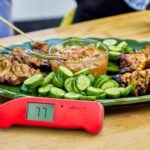Description
Harry Soo’s authentic Malaysian satay
Ingredients
For the marinade:
- ½ C curry powder
- ¾ C sambal (see recipe below, or use prepared sambal from the store)
- ¼ C brown sugar, or more to taste
- ¼ C rice vinegar
- ¼ C coconut milk
For the skewers:
- 2 thin-cut ribeyes (½” to ¾” thick)
- 4 boneless/skinless chicken thighs
- BBQ rub of your choice, or salt and pepper
- Wood or metal skewers
- 2 Tbsp unsalted butter, softened
- 1 C coconut milk
For the quick pickle:
- 6 Persian cucumbers
- ½ C rice vinegar
- ½ C granulated sugar
- 2 Tbsp brown sugar
- Salt and pepper
For the satay sauce:
- ¾ C shelled unsalted peanuts
- 2 Tbsp brown sugar
- ¼ C sambal (see recipe below, or use prepared sambal from the store)
- 1 C coconut milk
- 1 Tbsp rice vinegar
Optional lemongrass brush, for stirring and basting:
6 to 10 stalks lemongrass
Instructions
- In a medium bowl, combine all ingredients for the marinade. Adjust to taste—you may prefer sweeter, tangier, or spicier.
- Cut ribeyes and chicken thighs into ½” strips, then toss with BBQ rub (or salt and pepper). Allow 5 to 10 minutes for dry brine to penetrate the meat.
- Add meat to marinade and toss to combine. Let stand for an hour, or refrigerate up to overnight.
- Meanwhile, make the quick pickle. In a medium bowl, combine rice vinegar, granulated sugar, and brown sugar. Add salt and pepper to taste, and adjust for acidity, adding more vinegar if necessary. Slice cucumbers into ½” rounds, and toss them in the pickling liquid. Let stand for an hour, or if you prefer a softer pickle, refrigerate overnight.
- If making the lemongrass brush, trim the root end of each lemongrass stalk, then split the final 6” of stalk lengthwise repeatedly with your knife, forming coarse bristles. Repeat with the remaining stalks, and bundle them into a sheaf at the leaf end with some kitchen twine or a rubber band.
- Assemble the skewers: working with beef and chicken separately, fold each strip of marinated meat and thread it onto a skewer, about 2 to 3 strips per skewer. Make sure the tip of each skewer is covered by the last piece of meat, so that it does not burn when grilling.
- Set up your grill for 2-zone cooking, placing aluminum foil over the indirect section of the grill.
- In a small bowl, combine unsalted butter and coconut milk.
- When grill is hot, place skewers so that the meat cooks over the direct side, with the bare skewers over the indirect side and protected by the aluminum foil. Cook, turning frequently, and basting generously after each turn with the butter/coconut milk mixture.
- Pull the beef skewers when their internal temperature reads 135–140°F on your Thermapen. The chicken skewers can be pulled at an internal temp of 165°F, but improve at 175 to 185°F (if they start to scorch before this internal temperature is reached, just move them to the indirect side of the grill, and close the lid to cook indirectly until they come to temp).
- While the skewers rest, make the satay sauce: in a medium saucepan, roast peanuts over high heat until they show just a bit of scorching on the outside (or use a torch to lightly char them in the pan). Remove the pan from the heat, and lightly crush peanuts with the end of a rolling pin or other blunt instrument.
- Return pan to medium heat and add brown sugar, tossing with the peanuts until the sugar is lightly caramelized. Add sambal, coconut milk, and vinegar; combine. Adjust sauce to taste for acidity, sweetness, and/or spice.
- Serve skewers with sauce and pickle; enjoy them while they last!
For the Sambal:
Ingredients:
- 1 C red onion, chopped
- ¼ C fresh lemongrass, succulent part, finely chopped (or use pre-chopped lemongrass)
- ¼ C fresh ginger, finely chopped
- 3 Tbsp fresh garlic, finely chopped
- 4 oz red curry past
- 1 can coconut milk
- ¾ C reconstituted tamarind pulp
- 1 C brown sugar
- 4 Tbsp oil (as needed)
Instructions
- Heat half the oil in a sauté pan, add the onion and lemongrass and cook until the onion is translucent and just starting to brown.
- Add the ginger to the pan and cook, stirring, until the ginger is quite fragrant.
- Add the garlic and, if needed, more oil to the pan. Cook about 2 minutes, until the garlic smell loses some of its harshness.
- Add the curry paste and stir to combine, cooking until the paste is well incorporated.
- Add about ½ the can of coconut milk and cook, stirring, until somewhat thickened. Squeeze the tamarind pulp, avoiding seeds if possible, into the mixture. Stir to combine.
- Add the sugar and the rest of the coconut milk.
- Simmer, stirring occasionally and adjusting seasoning to your taste, until the mixture is well thickened, almost spoonable. (It will thicken more as it cools.)
- Cool, store refrigerated in an airtight container.
